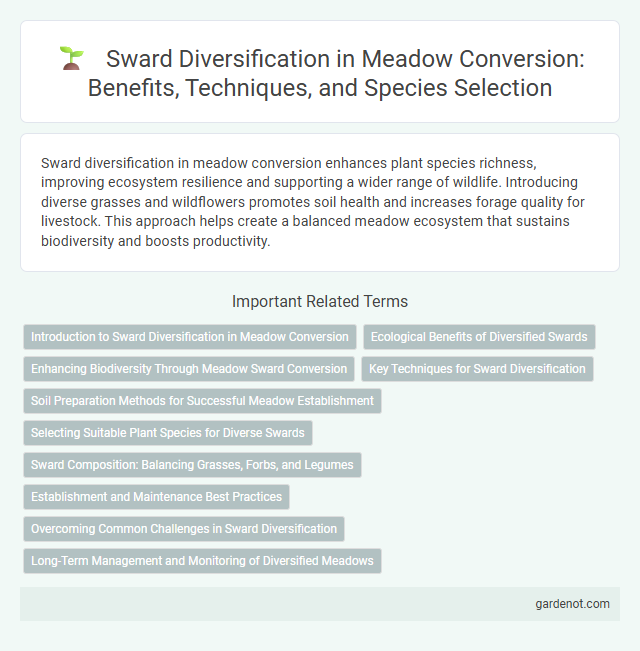Sward diversification in meadow conversion enhances plant species richness, improving ecosystem resilience and supporting a wider range of wildlife. Introducing diverse grasses and wildflowers promotes soil health and increases forage quality for livestock. This approach helps create a balanced meadow ecosystem that sustains biodiversity and boosts productivity.
Introduction to Sward Diversification in Meadow Conversion
Sward diversification in meadow conversion enhances pasture productivity and resilience by introducing a mix of grass species and legumes tailored to specific soil and climatic conditions. Diverse swards improve nutrient cycling, boost forage quality, and support biodiversity, which leads to sustainable grazing systems and increased ecosystem services. Integrating species such as clover, ryegrass, and fescues optimizes biomass yield and soil health, crucial for efficient meadow conversion strategies.
Ecological Benefits of Diversified Swards
Diversified swards enhance soil health by promoting a balanced microbial ecosystem and improving nutrient cycling through the presence of varied plant species. This ecological benefit supports increased pollinator activity and provides habitat for beneficial insects, which contributes to pest control and biodiversity conservation. Furthermore, mixed-species swards improve resilience against drought and disease, fostering sustainable pasture ecosystems.
Enhancing Biodiversity Through Meadow Sward Conversion
Meadow sward conversion significantly enhances biodiversity by introducing a diverse mix of native grasses and wildflowers that support a wide range of pollinators and soil microorganisms. Incorporating species such as red clover, bird's-foot trefoil, and Yorkshire fog creates varied habitats that increase invertebrate populations and improve ecosystem resilience. This sward diversification promotes balanced nutrient cycling and reduces reliance on chemical inputs, fostering a sustainable and thriving meadow ecosystem.
Key Techniques for Sward Diversification
Key techniques for sward diversification in meadow conversion include selecting a mix of grass species and legumes that enhance biodiversity and soil fertility. Incorporating deep-rooted plants improves soil structure and moisture retention, promoting ecosystem resilience. Regular monitoring and adaptive management ensure optimal species balance and productivity.
Soil Preparation Methods for Successful Meadow Establishment
Effective soil preparation methods such as deep plowing, harrowing, and soil testing are essential for successful meadow establishment and sward diversification. Incorporating organic matter, adjusting pH levels, and ensuring proper drainage promotes a healthy seedbed that supports diverse grass and wildflower species. These practices enhance root development, nutrient availability, and water retention, leading to a resilient and ecologically rich meadow sward.
Selecting Suitable Plant Species for Diverse Swards
Selecting suitable plant species for diverse swards involves prioritizing native and resilient varieties that enhance soil health and support pollinators. Incorporating a mix of grasses, legumes, and wildflowers ensures year-round coverage, improves nutrient cycling, and boosts biodiversity. Effective sward diversification requires careful consideration of site conditions, including soil type, moisture levels, and management objectives to optimize meadow conversion success.
Sward Composition: Balancing Grasses, Forbs, and Legumes
Sward diversification enhances meadow productivity by optimizing the balance between grasses, forbs, and legumes, which improves nutrient cycling and forage quality. Incorporating a diverse sward composition increases resilience to environmental stressors and supports beneficial soil microorganisms. Targeted selection of species based on site conditions maximizes ecosystem services and long-term meadow sustainability.
Establishment and Maintenance Best Practices
Sward diversification enhances meadow resilience by promoting a balanced mixture of grasses, legumes, and herbs that improve soil fertility and forage quality. Establishment best practices include selecting site-specific species, preparing a well-drained seedbed, and ensuring optimal sowing conditions such as seed depth and timing to maximize germination rates. Maintenance involves regular monitoring, appropriate mowing heights to prevent dominance of aggressive species, and timely reseeding to maintain species balance and long-term productivity.
Overcoming Common Challenges in Sward Diversification
Sward diversification enhances meadow productivity and resilience by integrating a variety of grass and legume species adapted to local conditions. Overcoming common challenges in sward diversification involves addressing issues such as seed establishment, competition from dominant species, and soil nutrient imbalances through targeted sowing techniques and soil management practices. Employing precision agriculture tools and selecting appropriate species mixtures can significantly improve establishment success and long-term sward stability.
Long-Term Management and Monitoring of Diversified Meadows
Sward diversification enhances meadow resilience by promoting a variety of plant species with different root depths, growth patterns, and seasonal behaviors, ensuring ecosystem stability over time. Long-term management involves rotational grazing or periodic cutting to maintain species richness and prevent dominance by aggressive species, thereby preserving habitat quality for pollinators and wildlife. Continuous monitoring using botanical surveys and remote sensing technologies tracks changes in species composition and sward structure, guiding adaptive management to sustain biodiversity and ecosystem services.
Sward diversification Infographic

 gardenot.com
gardenot.com